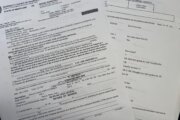In the world of investing, brand loyalty can sometimes lead individuals to concentrate their assets with a single provider. A notable example is the “Bogleheads” community.
Centered around the passive investment principles espoused by the late Vanguard founder and chairman, John Bogle, many Bogleheads choose to utilize Vanguard’s brokerage platform and invest in Vanguard funds over other alternatives.
However, Vanguard isn’t the sole provider in the industry. Other firms like Charles Schwab Corp. (ticker: SCHW) have carved out a significant niche by offering services and products that are both affordable and accessible.
[Sign up for stock news with our Invested newsletter.]
On average, Schwab-branded funds feature an asset-weighted expense ratio of just 0.04% for passively managed funds. Furthermore, investors can appreciate the absence of sales loads and the convenience of no transaction fees.
The importance of these benefits cannot be overstated. Low expense ratios ensure that more of an investor’s money is working for them rather than being consumed by administrative costs. The absence of sales loads and transaction fees, on the other hand, translates to direct savings, allowing investors to fully utilize their capital.
The firm’s brokerage platform has garnered praise as well for its accessibility. “A factor that makes Schwab a top fund provider for me is the user-friendly platform they provide for researching, buying and managing funds,” says Jim Penna, senior manager of retirement services at VectorVest. “You can scan and research anything from money market funds to international markets and more.”
Finally, Schwab also offers great breadth with its mutual fund lineup, with 50 funds in categories ranging from index, active equity, international, real estate, bond, monthly income and asset allocation. Investors of all risk tolerances, objectives and time horizons can easily find the right fund or combination of funds to suit their needs.
“What makes Charles Schwab stand out is their commitment to providing a diverse range of investment options to suit the needs of all types of investors,” says Andrew Latham, director of content at SuperMoney.com.
Here are seven of the best Charles Schwab mutual funds of 2023:
| Mutual fund | Expense ratio |
| Schwab S&P 500 Index Fund (SWPPX) | 0.02% |
| Schwab Total Stock Market Index Fund (SWTSX) | 0.03% |
| Schwab U.S. Large-Cap Growth Index Fund (SWLGX) | 0.035% |
| Schwab U.S. Large-Cap Value Index Fund (SWLVX) | 0.035% |
| Schwab Small-Cap Index Fund (SWSSX) | 0.04% |
| Schwab International Index Fund (SWISX) | 0.06% |
| Schwab Dividend Equity Fund (SWDSX) | 0.89% |
Schwab S&P 500 Index Fund (SWPPX)
“As in any fund you may consider, there are certain characteristics to always look for, starting with expense ratios, and the Schwab index funds have a favorable expense for passive funds,” Penna says. “For example, SWPPX has an expense ratio of just 0.02%.” In other words, investors who buy $10,000 worth of this Schwab fund can expect to pay just $2 in annual fees.
This low-cost Schwab fund tracks the popular S&P 500, which holds 500 large- and mid-cap U.S. stocks from across all 11 market sectors. Its passive index tracking strategy ensures a low portfolio turnover of just 1.8%, making it a relatively tax-efficient option as well. This fund has been around since 1997 and has since attracted over $72 billion in assets under management, or AUM.
Schwab Total Stock Market Index Fund (SWTSX)
“One Schwab fund that is worth considering is SWTSX, which offers broad exposure to the entire U.S. equity market and has a low expense ratio of 0.03%,” Latham says. While slightly more expensive than SWPPX, SWTSX is arguably much more diversified given that it tracks the Dow Jones U.S. Total Stock Market Index, a benchmark of overall domestic market performance.
While the S&P 500 only focuses on around 500 large- and mid-cap stocks, the Dow Jones U.S. Total Stock Market Index holds around 4,000 large-, mid- and small-cap stocks. Despite this much larger portfolio, the fund still manages to achieve a low portfolio turnover of 2%. Historically, the performance and sector composition of SWTSX has been comparable to that of SWPPX.
Schwab U.S. Large-Cap Growth Index Fund (SWLGX)
Investors looking to fine-tune their portfolio further and slice-and-dice based on certain types of stocks can use a style fund like SWLGX. This fund tracks the Russell 1000 Growth Index, which screens the broader Russell 1000 Index for stocks based on metrics that include high earnings growth rates, low dividends and free cash flow. The fund charges a 0.035% expense ratio.
SWLGX’s index strategy results in a more concentrated and top-heavy portfolio. In terms of the former, investors can expect a 43.3% exposure to technology sector stocks. For the latter, just two stocks, Apple Inc. (AAPL) and Microsoft Corp. (MSFT) make up 12.1% and 11.1% of the fund, respectively. The fund also has a much higher 18% annual turnover rate due to its more stringent index criteria.
Schwab U.S. Large-Cap Value Index Fund (SWLVX)
The counterpart of SWLGX is SWLVX, which has a value investing focus. This fund focuses on the largest 70% of U.S. stocks screened for low price-to-book, price-to-sales and price-to-cash-flow ratios and high dividend yield ratios. The benchmark it tracks is the Russell 1000 Value Index, the opposite of the one tracked by SWLGX. SWLVX also charges a 0.035% expense ratio.
The composition of SWLVX’s portfolio is also markedly different. Investors can expect higher exposure to financial and health care sector stocks at 20.1% and 15.8%, respectively. The portfolio is also much less top-heavy, with the three largest holdings being Berkshire Hathaway Inc. (BRK.A, BRK.B), Exxon Mobil Corp. (XOM) and JPMorgan Chase & Co. (JPM) at 3.4%, 2.5% and 2.2%, respectively.
[SEE: 7 Best Value ETFs to Buy and Hold]
Schwab Small-Cap Index Fund (SWSSX)
Investors willing to take on higher risk for the potential of a greater return can dial in their strategy via a small-cap fund like SWSSX. By tracking the Russell 2000 Index, SWSSX provides exposure to the bottom decile, or 10%, of the U.S. equity market by market capitalization size. The fund is style agnostic, meaning that unlike SWLGX or SWLVX, it does not tilt toward growth or value stocks.
Overall, SWSSX is very diversified, with a total of over 1,900 holdings split fairly evenly. Industrial stocks lead the way at a 17.2% allocation, followed by health care at 16.9%, financials at 15.1% and technology at 13.7%. However, keep in mind that small caps have historically produced greater volatility, and investors must be able to stay the course through periods of underperformance for success.
Schwab International Index Fund (SWISX)
Investors looking for maximum diversification with respect to their equity allocation may wish to consider adding international stocks. While the U.S. market may have outperformed over the prior decade, it has also historically experienced periods of prolonged stagnation, such as the “lost decade” of 1999 to 2009. To mitigate this risk, investors can diversify via SWISX.
This fund tracks the MSCI EAFE Index, which provides exposure to around 800 stocks from international developed markets. Countries represented in this index include the likes of Japan, the U.K., France, Switzerland, Germany, Australia and more. For a 0.06% expense ratio, investors can access a wide swath of international stocks without converting currency or buying American depositary receipts.
Schwab Dividend Equity Fund (SWDSX)
“Some investors just want to track an index and be very passive in the market, such as those with a really long investment horizon,” says Anessa Custovic, chief investment officer at Cardinal Retirement Planning Inc. “But if you have a much shorter time horizon for your investment goals, you might want to think about an actively managed fund to manage risk or increase returns.”
Dividend investors may prefer an actively managed Schwab fund like SWDSX, which pays a 2.3% 30-day SEC yield. This fund currently holds a concentrated portfolio of 55 holdings selected based on fundamentals like higher dividend yields, favorable valuations and price momentum. However, keep in mind that as an actively managed fund, SWDSX has a much higher 0.89% expense ratio and 27% portfolio turnover.
[READ: 6 of the Best Fidelity Mutual Funds to Buy and Hold.]
More from U.S. News
7 Best Vanguard Funds for Retirement
Stock Market Sectors 101: A Guide to All 11 Sectors
7 of the Best Charles Schwab Mutual Funds originally appeared on usnews.com
Update 10/16/23: This story was published at an earlier date and has been updated with new information.







